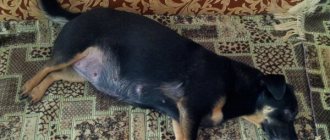Medically unjustified interference with the body is actively condemned among animal rights activists. Because of this, more and more owners doubt whether it is possible to crop their dogs’ ears. There is no exact answer to this question, so most often the decision remains on the conscience of the animal owner.
What is ear cropping in dogs?
Cupping is a partial or complete amputation of the ears. The length left depends on the standard assigned to the particular breed.
This operation began with the ancient Romans and Greeks, who shortened the ears of fighting and hunting dogs for safety purposes. Short ears were more difficult to grab with teeth or scratch with bushes. Amputation also reduced the risk of infection by mites and reduced the likelihood of inflammation due to insufficient ventilation of the ear canal.
Feasibility of the procedure
Since the 20th century, most European countries have opposed the operation, banning it at the national level by signing a convention. Changes have been made to the established conformation of many breeds, easing the rules for taking part in a dog show. The natural shape of the ears was no longer a serious obstacle to receiving an honorary title, so the only argument in favor of amputation remained only medical indications.
Exterior of the breed
Folding ears have always been associated with good nature. Such a soft image does not fit at all with the Doberman and other fighting breeds. For this reason, proponents of cupping continue to support its appropriateness, citing aesthetics.
Health recommendations
Due to insufficient ear ventilation, fold-eared breeds often suffer from otitis media. These dogs have their ears cropped for preventive purposes. Surgery is also used in the presence of the following medical indications:
- multiple ulcerations that prevent self-regeneration of the skin;
- burns and mechanical injuries;
- necrotic formations;
- tumors.
Relaxations are also made for those who perform guard duty or help their master on the hunt. In addition to protecting against parasites and infections, short erect ears are much better at picking up sounds. This makes it easier to catch violators and chase prey.
Arguments against
Animal rights activists focus on the dangers of anesthesia, the painfulness of the procedure and possible complications characteristic of any surgical intervention. No less important is the partial loss of the means of communication, since locators on the head participate in the communication process along with the tail.
If you nevertheless decide to amputate for the sake of preserving the historically established exterior, make sure that your actions are legal. In some countries, cropped ears can be a serious reason for refusing to participate in an exhibition.
Pros and cons
The opinions of dog handlers and breeders have been divided regarding this procedure for a long time..
Some argue that the Doberman's natural appearance - long ears and tail - is acceptable. The latter are inclined to think that the dog will be more comfortable with docked ones, plus this adds more aesthetics to the animal’s exterior.
Here are all the pros and cons regarding cropping Doberman ears.
Advantages:
- Ear cropping does not in any way affect the development, health or life expectancy of the Doberman;
- Gives the dog's head an aesthetically pleasing appearance;
- In hunting and dog fighting it will help to avoid additional injuries;
- To some extent reduce the risk of ear diseases;
- The Doberman will take on a more familiar appearance.
Flaws:
- Inadmissibility to participate in international exhibitions;
- Complex process of ear placement;
- It will be more difficult for the animal to express its emotions, because with the help of its ears it can also convey its mood;
- The procedure is only for the dog to meet human standards of Doberman beauty.
Expert opinion
Kozhevin Semyon Kirillovich
Expert dog handler.
“It is a myth that the tail and ears interfere with the Doberman in everyday life. If a dog is born with them, it means that he will fully learn to use them, because these are parts of his body. But nature doesn’t give anything for nothing: a tail, for example, is needed to control the body in a jump, and the fact that a Doberman can cope with this without it does not mean that it does not need it. Same with the ears. Here only the owner decides how he likes to see his pet.”
What breeds need the procedure?
According to international standards, amputation is recommended for almost all working, hunting and fighting breeds. The main condition is that the ears are too long, unable to stand on their own from birth.
List of breeds
The most famous representatives include:
- miniature pinschers;
- American Staffordshire Terriers;
- alabai;
- Caucasian Shepherd Dogs;
- Cane Corso;
- pit bull terriers;
- boxers;
- Dobermans;
- Great Danes;
- toy terriers.
The recommended length and subsequent placement of cropped ears are different for these dogs. For this reason, it is very important to find an experienced veterinarian who is aware of all the nuances.
Features of cupping for each of them
Let's consider the main features of amputation for each of the previously listed breeds:
- miniature pinschers
. This miniature version of the Doberman is a decorative breed, so docking is used solely from an aesthetic point of view. It is carried out at 3 months. After removing the sutures, they resort to mandatory fixation with cotton swabs.
- American
Staffordshire Terriers
. Amstaffs are circumcised at 1.5-3 months, choosing the length depending on the animal’s field of activity. The maximum length is reserved for show pets, and the minimum length for working dogs. Amputated ears easily take the desired shape without an additional frame. - Alabai
. Representatives of this breed often suffer from heavy blood loss, so they are operated on within 3 days after birth. The shape is selected to be as short as possible, that is, no more than 1/3 of cartilage.
- Caucasian
Shepherd Dogs
. The recommended timing and form are similar to Alabai. Later intervention is not recommended, since manipulation of the hardened tissue often leads to complications. - Cane-Corso
. Using the procedure, hanging ears are turned into neat rounded triangles. They stand up very well on their own, but for reliability they are still fixed with adhesive tape.
- Pit bull terriers
. The methodology and recommended age are similar to amstaffs. It is better to sign up for surgery 2 weeks after vaccination.
- Boxers
. The final shape resembles horns, and the recommended age is 2 months.
- Dobermans
. Here it is recommended to do it before the onset of 2 months, that is, before the change of baby teeth. Only 2/5 of the animal’s ears are cut off, making sure to secure the shell with clamps and bandages.
- Great Danes
. Dogs are registered for docking at 2.5-4 months. They cut off 1.5-3 cm of the ear tissue and fix it all using a structure for Dobermans. The only difference is the size of the materials used.
- Toy Terriers
. Another decorative dog undergoing the procedure solely for aesthetic purposes. They are docked at 2 months, be sure to secure the cropped ears with a tight bandage for proper placement.
Despite some age differences, there is a limit that is the same for everyone - 4-6 months. We are talking about the upper limit when cutting becomes very painful due to the development of pain memory.
Postoperative care
On the first day, the puppy’s head must be bandaged to avoid excessive bleeding. When the bandages are removed, the ears are disinfected with a solution of brilliant green, and this is done daily. A protective collar is put on the dog.
While the specialist has not removed the stitches, the ears are gently massaged so that the skin does not wrinkle during healing. If your pit bull whines for a long time, your veterinarian may prescribe pain medication. Such drugs are necessary for adult animals. The stitches are removed by a specialist a week or 10 days after the operation.
If you need the puppy's ears to be erect, they are glued in a special way. Rollers are placed inside the ears and secured in a standing position.
Possible complications
Complications during cupping are the same as with any surgical intervention. It is necessary to keep the circumcision sites clean and constantly disinfect them to avoid infection.
It’s bad when a few days after the operation there is heavy bleeding - the dog needs to be shown to a specialist. In adult dogs, a typical complication is scars on the ears. Therefore, docking an adult pit bull terrier is quite rare.
Until what age do dogs have their ears cropped?
The easiest time to undergo the operation is shortly after birth. Up to 2 weeks, babies are less sensitive to pain and do not remember it, and their tissues regenerate much faster. The only negative is increased bleeding.
After 4-6 months, the pain worsens, and large scars often remain at the site of circumcision. For this reason, the average age for ear cropping in dogs ranges from 2 weeks after birth to 3 months, and the maximum is 4-6 months. At a later age, amputation is resorted to only for medical reasons.
Optimal age for cupping
Experts call completely different dates. Some crop ears at the age of 1-2 weeks. At this time, the pit bull puppy’s blood vessels and nerve endings at the site of the cut are not yet sufficiently developed, which means that during the operation he will lose little blood and the baby will not be in as much pain.
Others believe that the optimal age is 2-3 months. But such deadlines are dictated only by the requirements of the exterior. At this age, you can already predict what an adult pit bull with cropped ears will look like.
Progress of the procedure step by step
The animal is operated on in a veterinary clinic or directly at home. Despite the attractiveness of the latter method, it is better not to resort to it. At home, it is more difficult to maintain sterility and provide first aid in case of complications.
The duration of the procedure takes 30-60 minutes. To crop dogs' ears, a pattern is used - a metal stencil that matches the required shape.
immediate docking begins
- The pattern is fixed to the shells using clamps to prevent bleeding.
- The excess part of the ear tissue is cut off with a scalpel. If there are large blood vessels, the edges of the wound are cauterized.
- The operated part is sutured, treated with antibiotics and a special healing glue.
The awakened pet is returned to the owner. The postoperative period lasts 7-10 days.
Caring for the animal after surgery
After cropping, the dog's ears are tightly bandaged, making correct positioning easier. A veterinary cone is used to protect against injury. Until the wounds heal, it is necessary to ensure that they are clean and the edges are dry. Otherwise, suppuration or deformation of the ears may occur.
Posting is done only after the stitches are removed. To do this, use a special massage and fixing structures made of cotton swabs and adhesive tape. While wearing such a corset, the ears gradually take the desired shape. Most often, production takes 14-20 days.
Ear placement
When trimming a Doberman's ears, your veterinarian may use three types of clip molds:
- straight;
- curved;
- zigzag.
After processing the edges, it is necessary to ensure that the cropped ears do not dangle, but stand straight. To do this, immediately after the operation they are wrapped in a bandage. It is connected to each other in such a way that the ears point upward. A cotton swab or foam rubber rim will help to strengthen the structure.
In order for the tissue to heal faster, it is necessary to step back from the head and the seam at a distance of 1-2 cm. In this case, it is possible to treat the scar daily and identify the occurrence of side effects. In addition, in the fresh air, all wounds heal faster than under a bandage.
Possible complications
Complications do not always occur due to poor surgeon performance and careless postoperative care. Often the individual characteristics of the animal are to blame for their appearance. Possible consequences include:
- bleeding, fraught with heavy blood loss;
- large scarring that worsens the appearance of the ear;
- wound infection and subsequent inflammation, requiring repeated surgery.
If your dog’s health worsens, be sure to contact the veterinarian who performed the amputation. Remember that taking medications without a doctor's prescription is strictly prohibited.
Why don't that terrier have ears?
So we get to the most interesting question - why that terrier doesn’t have ears. And is this a problem or not? The cartilage in the ear itself is fragile. We already understood this. In order to understand how the formation and development of the base of the erect ear will occur, let’s return to the birth of the puppy.
Initially from the mother, the puppy inherits appearance and health. If the mother had health problems, then where will the heroic spirit come from in a small body? After the birth of the baby, responsibility for its life activities falls on the breeder. He takes care of the adequate nutrition of the lactating bitch and, accordingly, the growing toy puppy.
Mating of long-haired and short-haired representatives of the breed has become widespread. And since in long-haired toys even the standard allows for non-standing “locators”, the smooth-haired child can only achieve “ears on top” if the breeder correctly selects the parents. A shaggy mother and a smooth father (or, conversely), puppies will not have problems with ear support if the nursery pays attention to the quality and strength of the cartilage in the hearing organs during selection.
If the parent’s hearing organs are not heavily covered with hair, or the fringe on the ears does not burden the hearing organ itself, then everything will be fine for the babies. Although, as you understand, this is a guessing game. Therefore, puppies that are planned to be taken to shows in the future should not be taken from a breeding of miniature terriers with varying degrees of hairiness.
Okay, you got a puppy from parents with short hair and no ears. You are not alone. Such cases indicate only one thing: that your little terrier has weak cartilage in the ear. There is only one reason for this, besides heredity - the dog suffers from a deficiency of calcium, vitamins and minerals. A terrier whose ears do not stand up needs to take a course of vitamin supplements consisting of glucosamine, collagen, and chondroitin. If, according to the doctor's indications, the dog cannot take vitamins (so as not to upset his stomach), then calcium glycerophosphate is prescribed.
During this period, the toy terrier’s diet must include nutrients with vitamin and mineral supplements. If you feed with ready-made supplements, then it’s all there. If your dog eats homemade food, then include calcined cottage cheese in your pet’s menu.
Advice
You can make homemade cottage cheese for your toy yourself. To do this, bring half a liter of fresh milk to a boil, add one tablespoon of calcium chloride to it, and then discard the resulting clots in a colander. It's simple!
If you don’t want to cook or don’t have time, then ask your veterinarian to recommend medications with easily digestible calcium. With food or in ready-made form, calcium will become a catalyst for the necessary metabolic processes in the dog’s body, which are necessary for the rigidity of cartilage.
Is it possible to perform ear trimming at home?
Pruning is done strictly by a veterinarian. Carrying out the procedure by a person without the appropriate education can result in the death of the animal from excessive blood loss, incorrectly selected anesthesia, or sepsis due to insufficient disinfection.
Calling a surgeon to your home is possible, but it also carries a number of risks. To be safe, it is recommended to neglect the psychological comfort of the animal in a familiar environment and carry out the operation according to all the rules - in the clinic.
Approximate cost of the operation
The average price ranges from 300 to 1500 rubles. The final cost depends on the city, the prestige of the clinic, the level of qualifications of the veterinarian, the age of the pet, the complexity of the case and the need for a home visit.
Conclusion
It is necessary to crop a dog's ears with great care, since saving on this procedure can result in the death of the animal. If you do not plan to participate in exhibitions and breeding, then it is better to accept your pet as it is. Droopy ears will not affect behavior and other important qualities, so you should not tempt fate to conform to an ideal that has long lost its relevance.
The article is for informational purposes only. Contact your veterinarian!











